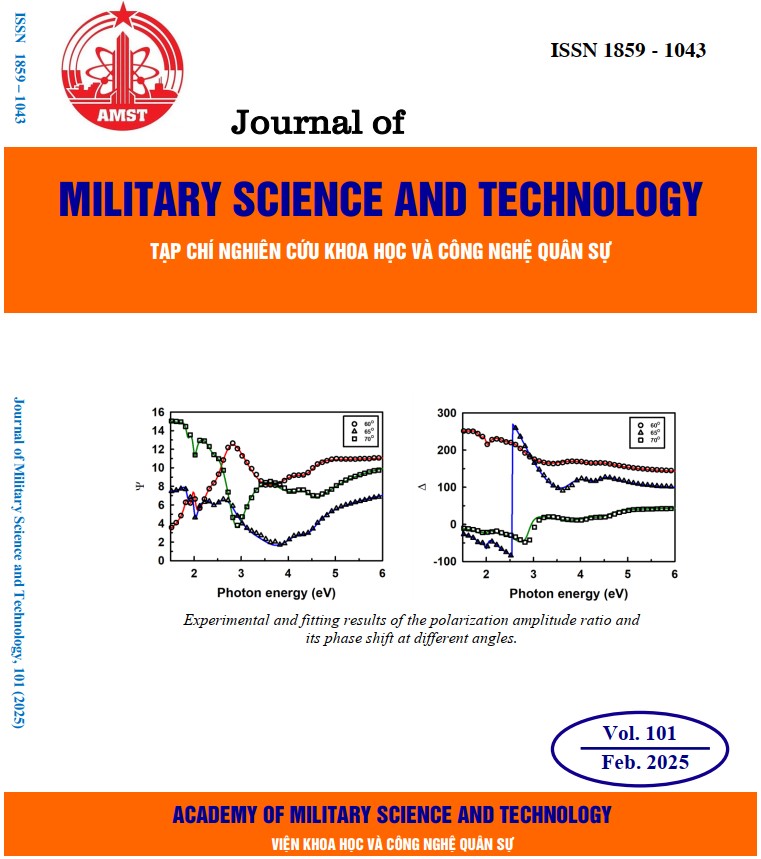Nghiên cứu chế tạo vật liệu composite trên cơ sở nền nhựa polyester không no, cốt vỏ trấu biến tính
425 lượt xemDOI:
https://doi.org/10.54939/1859-1043.j.mst.101.2025.72-80Từ khóa:
Vỏ trấu; Sợi thiên nhiên; UPE composite; 3-methacryloxypropyl trimethoxy silane; Cơ tính.Tóm tắt
Trong nghiên cứu này, vỏ trấu (RHs) đã được sử dụng làm chất độn để tạo pha gia cường trong quá trình chế tạo vật liệu composite nền polyeste không no (UPE). Mục tiêu là duy trì cơ tính vật liệu ở một mức độ nhất định và thay thế một phần lượng nhựa nhiệt rắn sử dụng để hạn chế tác động tiêu cực đến môi trường. Trong đó, sodium hidroxide (NaOH) và 3-methacryloxypropyl trimethoxy silane (MPS) được sử dụng trong quá trình biến tính RHs. Cấu trúc và hình thái của RHs biến tính được khảo sát bằng quang phổ hồng ngoại biến đổi Fourier (FTIR) và kính hiển vi điện tử quét (FESEM). Bên cạnh đó, tính chất cơ học của các mẫu composite được đo theo các tiêu chuẩn quốc tế như ISO 527:-2012, ISO 178:2019, ISO 604:2002 và ASTM D256. Kết quả cho thấy, RHs biến tính lần lượt bằng dung dịch NaOH và dung dịch MPS đã cải thiện đáng kể các tính chất cơ lý của mẫu composite tương ứng. Cụ thể, so với mẫu tham chiếu tạo thành từ RHs thô, mẫu tốt nhất (trong số các composite với RHs được biến tính hai giai đoạn) đạt độ bền uốn tăng khoảng 34.1% (đạt 45.1 MPa), độ bền nén tăng khoảng 51.6% (đạt 33.8 MPa), độ bền kéo tăng khoảng 44.6% (đạt 34.3 MPa), độ bền va đập là 6.3 Kj/m2 (cao hơn 18.9%). Các kết quả này cho thấy, RHs biến tính có thể đáp ứng các mục tiêu nghiên cứu đã đề ra, đồng thời tạo tiền đề cho các nghiên cứu tiếp theo về composite kết hợp vỏ trấu.
Tài liệu tham khảo
[1]. M. Gun et al., "Optimization of Silica Extraction from Rice Husk Using Response Surface Methodology and Adsorption of Safranin Dye," International Journal of Environmental Research, vol. 16, no. 2, p. 20, (2022). DOI: https://doi.org/10.1007/s41742-022-00399-5
[2]. N. Karić et al., "Bio-waste valorisation: Agricultural wastes as biosorbents for removal of (in)organic pollutants in wastewater treatment," Chemical Engineering Journal Advances, vol. 9, p. 100239, (2022). DOI: https://doi.org/10.1016/j.ceja.2021.100239
[3]. L. Q. Dien et al., "Rice husk integrated biochemical refinery for the production of nano- and bioproducts," Process Biochemistry, vol. 121, pp. 647-655, (2022). DOI: https://doi.org/10.1016/j.procbio.2022.08.009
[4]. B. S. Ndazi et al., "Chemical and physical modifications of rice husks for use as composite panels," Composites Part A: Applied Science and Manufacturing, vol. 38, no. 3, pp. 925-935, (2007). DOI: https://doi.org/10.1016/j.compositesa.2006.07.004
[5]. P. Senthamaraikannan and M. Kathiresan, "Characterization of raw and alkali treated new natural cellulosic fiber from Coccinia grandis.L," Carbohydrate Polymers, vol. 186, pp. 332-343, (2018). DOI: https://doi.org/10.1016/j.carbpol.2018.01.072
[6]. S. Sreenivasan et al., "Evaluation of Combined Treatments of Natural Fibers: Kenaf, Abaca and Oil Palm Fibers Using Micromechanical and SEM Methods.," AMR 912–914, 1932–1939., (2014). DOI: https://doi.org/10.4028/www.scientific.net/AMR.912-914.1932
[7]. V. A. Yiga et al., "Thermal stability of NaOH modified rice husk fiber-reinforced polylactic acid composites: Effect of rice husks and clay loading," Results in Materials, vol. 18, p. 100398, (2023). DOI: https://doi.org/10.1016/j.rinma.2023.100398
[8]. V. A. Yiga et al., "Modified rice husk as component in recyclable and biodegradable epoxy thermosets," Discover Applied Sciences, vol. 6, no. 4, p. 175, (2024). DOI: https://doi.org/10.1007/s42452-024-05834-0
[9]. Y. Nakamura et al., "Characterization of cellulose microfibrils, cellulose molecules, and hemicelluloses in buckwheat and rice husks," Cellulose, vol. 26, no. 11, pp. 6529-6541, (2019). DOI: https://doi.org/10.1007/s10570-019-02560-4
[10]. L. Mohammed et al., "A review on natural fiber reinforced polymer composite and its applications," vol. 2015, (2015). DOI: https://doi.org/10.1155/2015/243947
[11]. A. Dilfi et al., "Effect of surface modification of jute fiber on the mechanical properties and durability of jute fiber-reinforced epoxy composites," vol. 39, pp. E2519-E2528, (2018). DOI: https://doi.org/10.1002/pc.24817
[12]. M. H. Hamidon et al., "Effects of fibre treatment on mechanical properties of kenaf fibre reinforced composites: a review," Journal of Materials Research and Technology, vol. 8, no. 3, pp. 3327-3337, (2019). DOI: https://doi.org/10.1016/j.jmrt.2019.04.012
[13]. E. T. N. Bisanda and M. P. Ansell, "The effect of silane treatment on the mechanical and physical properties of sisal-epoxy composites," Composites Science and Technology, vol. 41, no. 2, pp. 165-178, (1991). DOI: https://doi.org/10.1016/0266-3538(91)90026-L
[14]. M. Bengtsson and K. Oksman, "Silane crosslinked wood plastic composites: Processing and properties," Composites Science and Technology, vol. 66, no. 13, pp. 2177-2186, (2006). DOI: https://doi.org/10.1016/j.compscitech.2005.12.009
[15]. A. K. Bledzki and J. Gassan, "Composites reinforced with cellulose based fibres," Progress in Polymer Science, vol. 24, no. 2, pp. 221-274, (1999). DOI: https://doi.org/10.1016/S0079-6700(98)00018-5
[16]. Y. Xie et al., "Silane coupling agents used for natural fiber/polymer composites: A review," Composites Part A: Applied Science and Manufacturing, vol. 41, no. 7, pp. 806-819, (2010). DOI: https://doi.org/10.1016/j.compositesa.2010.03.005
[17]. P. Gañán and I. J. J. o. m. s. Mondragon, "Fique fiber-reinforced polyester composites: Effects of fiber surface treatments on mechanical behavior," vol. 39, pp. 3121-3128, (2004). DOI: https://doi.org/10.1023/B:JMSC.0000025841.67124.c3
[18]. B. Singh et al., "Influence of fiber surface treatment on the properties of sisal‐polyester composites," vol. 17, no. 6, pp. 910-918, (1996). DOI: https://doi.org/10.1002/pc.10684
[19]. L. A. Pothan et al., "The role of fibre/matrix interactions on the dynamic mechanical properties of chemically modified banana fibre/polyester composites," vol. 37, no. 9, pp. 1260-1269, (2006). DOI: https://doi.org/10.1016/j.compositesa.2005.09.001
[20]. L. A. Pothan et al., "Polarity parameters and dynamic mechanical behaviour of chemically modified banana fiber reinforced polyester composites," vol. 63, no. 9, pp. 1231-1240, (2003). DOI: https://doi.org/10.1016/S0266-3538(03)00092-7
[21]. R. Arjmandi et al., "Rice Husk Filled Polymer Composites," International Journal of Polymer Science, vol. 2015, p. 501471, (2015). DOI: https://doi.org/10.1155/2015/501471
[22]. M. Abdelmouleh et al., "Modification of cellulose fibers with functionalized silanes: effect of the fiber treatment on the mechanical performances of cellulose–thermoset composites," vol. 98, no. 3, pp. 974-984, (2005). DOI: https://doi.org/10.1002/app.22133
[23]. D. Deepaky et al., "Bibliometric Analysis of Research Trends in Rice Straw/Husk Reinforced Polymer Composites," pp. 1-36, (2021).
[24]. A. A. Ajayi et al., "Development of epoxy-based sandwich composite panel with hollow glass microspheres/clay hybrid core and banana fiber facesheet for structural applications," Heliyon, vol. 10, no. 9, p. e30428, (2024). DOI: https://doi.org/10.1016/j.heliyon.2024.e30428
[25]. M. S. Yeasmin and M. I. H. Mondal, "Synthesis of highly substituted carboxymethyl cellulose depending on cellulose particle size," International Journal of Biological Macromolecules, vol. 80, pp. 725-731, (2015). DOI: https://doi.org/10.1016/j.ijbiomac.2015.07.040
[26]. G. Herbst et al., "Silane-modified high-yield lignocellulosic fibers as reinforcement of polylactic acid: Enhancement of interfacial adhesion for high-performance biocomposites," Industrial Crops and Products, vol. 218, p. 119027, (2024). DOI: https://doi.org/10.1016/j.indcrop.2024.119027
[27]. R. Javier-Astete et al., "Determination of hemicellulose, cellulose, holocellulose and lignin content using FTIR in Calycophyllum spruceanum (Benth.) K. Schum. and Guazuma crinita Lam," vol. 16, no. 10, p. e0256559, (2021). DOI: https://doi.org/10.1371/journal.pone.0256559
[28]. A. K. Mohanty et al., "Natural fibers, biopolymers, and biocomposites: an introduction," in Natural fibers, biopolymers, and biocomposites: CRC press, pp. 17-51, (2005). DOI: https://doi.org/10.1201/9780203508206.ch1
[29]. X. Li et al., "Chemical treatments of natural fiber for use in natural fiber-reinforced composites: a review," vol. 15, pp. 25-33, (2007). DOI: https://doi.org/10.1007/s10924-006-0042-3
[30]. P. K. Kushwaha et al., "Studies on water absorption of bamboo-polyester composites: effect of silane treatment of mercerized bamboo," vol. 49, no. 1, pp. 45-52, (2009). DOI: https://doi.org/10.1080/03602550903283026
[31]. M. Abdelmouleh et al., "Interaction of silane coupling agents with cellulose," vol. 18, no. 8, pp. 3203-3208, (2002). DOI: https://doi.org/10.1021/la011657g







